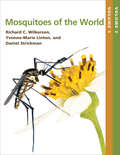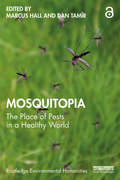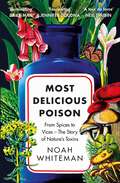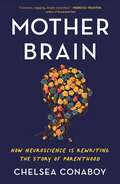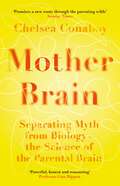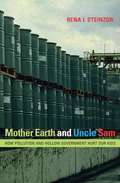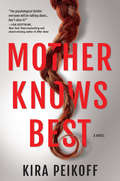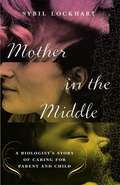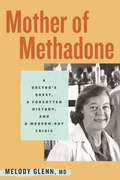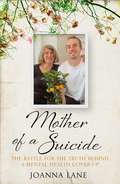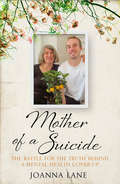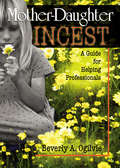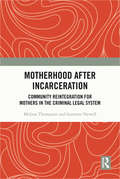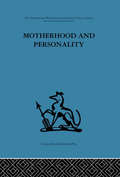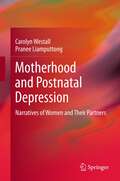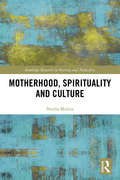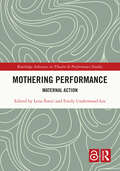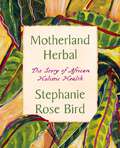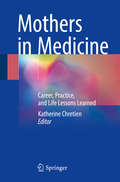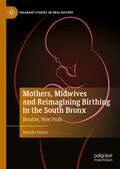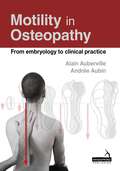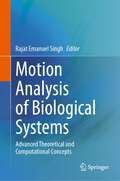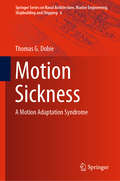- Table View
- List View
Mosquitoes of the World
by Daniel Strickman Richard C. Wilkerson Yvonne-Marie LintonBiting multiple times on two, three, or more different hosts, it is no surprise that some species of mosquitoes have co-evolved with pathogens. For humans and other animals, the result has been some of the most challenging diseases known. It has been said that Anopheles gambiae, as the primary transmitter of malaria parasites to humans, is the most dangerous animal in the world. Certainly malaria has killed more people than all the wars that ever took place. Even now, despite drugs and mosquito control, malaria claims the lives of 405,000 per year. The vast majority of mosquito species are not involved in pathogen transmission to humans, but those that are make a huge impact on global health.In this two-volume set, three of the world's leading experts on mosquito disease, ecology, and systematics offer readers unique insights into the fascinating world of mosquitoes while illustrating their diagnostic morphological features in detail. Comprehensively addressing the natural diversity of mosquitoes, the book explains their life histories, bionomic traits, and the physiological and physical adaptations they evolved in response to ever-changing environmental conditions. Mosquitoes are one of the best-known groups of insects, making this book a great starting place for anyone who would like to understand entomology by knowing the details about a representative family.Volume One contains a review of the biology and diversity of mosquitoes. Biology is treated in the following chapters: • Evolution• Nomenclature• Distribution• Development• Dormancy• Mosquito Movement• Feeding and Nutrition• Excretion• Copulation and Insemination• Egg Development and OvipositionThe chapters on biology are followed by a well-illustrated summary of the characteristics of all 41 genera and of representative species of mosquitoes. This treatment of the morphological diversity of mosquitoes is accompanied by a glossary of all morphological terms used. Volume Two features• a long-awaited comprehensive mosquito taxonomic catalog detailing the current taxonomic and systematic status of all 3,698 valid species and subspecies, 41 genera, and 187 subgenera• a list of all taxa for definitive use of nomenclature• complete lists of species synonyms, distributions, key taxonomic works, and newly defined informal names• origins of scientific namesReaders will discover that some mosquitoes undertake courtship rituals, while others guard their eggs, feed solely on earthworms, or can survive as immatures under ice sheets or in salt-encrusted pools. Hundreds of drawings and high-resolution, close-up images illustrate the text. The most complete reference work on mosquitoes ever produced, Mosquitoes of the World is an unmatched resource for entomologists, public health professionals, epidemiologists, and reference libraries.
Mosquitopia: The Place of Pests in a Healthy World (Routledge Environmental Humanities)
by MarcusDan Hall TamïrThis edited volume brings together natural scientists, social scientists and humanists to assess if (or how) we may begin to coexist harmoniously with the mosquito. The mosquito is humanity’s deadliest animal, killing over a million people each year by transmitting malaria, yellow fever, Zika and several other diseases. Yet of the 3,500 species of mosquito on Earth, only a few dozen of them are really dangerous—so that the question arises as to whether humans and their mosquito foe can learn to live peacefully with one another. Chapters assess polarizing arguments for conserving and preserving mosquitoes, as well as for controlling and killing them, elaborating on possible consequences of both strategies. This book provides informed answers to the dual question: could we eliminate mosquitoes, and should we? Offering insights spanning the technical to the philosophical, this is the “go to” book for exploring humanity’s many relationships with the mosquito—which becomes a journey to finding better ways to inhabit the natural world. Mosquitopia will be of interest to anyone wanting to explore dependencies between human health and natural systems, while offering novel perspectives to health planners, medical experts, environmentalists and animal rights advocates.
Most Delicious Poison: From Spices to Vices – The Story of Nature's Toxins
by Noah WhitemanA deadly secret lurks within our kitchens, medicine cabinets and gardens... Digitalis purpurea. The common foxglove. Vision blurs as blood pressure drops precipitously. The heartbeat slows until, finally, it stops. Atropa belladonna. Deadly nightshade. Eyes darken as strange shapes flutter across your vision. The heart begins to race and soon the entire body is overcome with convulsions. Papaver somniferum. The opium poppy. Pupils constrict to a pinprick as the senses dull. Gradually, breathing shudders to a halt. Scratch the surface of a coffee bean, a chilli flake or an apple seed and find a bevy of strange chemicals – biological weapons in a war raging unseen. Here, beetles, birds, bats and butterflies must navigate a minefield of specialised chemicals and biotoxins, each designed to maim and kill. And yet these chemicals, evolved to repel marauding insects and animals, have now become an integral part of our everyday lives. Some we use to greet our days (caffeine) and titillate our tongues (capsaicin), others to bend our minds (psilocybin) and take away our pains (opioids). Informed by his father&’s love of the natural world and his eventual spiral into the depths of addiction, evolutionary biologist Noah Whiteman explores how we came to use – and abuse – these chemicals. Delving into the mysterious origins of plant and fungal toxins, and their unique human history, Most Delicious Poison provides a kaleidoscopic tour of nature&’s most delectable and dangerous poisons. ***** 'Deeply researched and fascinating.' —JENNIFER DOUDNA, WINNER OF THE NOBEL PRIZE IN CHEMISTRY 'Magisterial, fascinating and gripping.' —NEIL SHUBIN, AUTHOR OF YOUR INNER FISH 'Exuberant, poignant and mind-blowing.' —DANIEL E. LIEBERMAN, AUTHOR OF EXERCISED
Mother Brain: How Neuroscience Is Rewriting the Story of Parenthood
by Chelsea ConaboyHealth and science journalist Chelsea Conaboy explodes the concept of “maternal instinct” and tells a new story about what it means to become a parent.Conaboy expected things to change with the birth of her child. What she didn’t expect was how different she would feel. But she would soon discover what was behind this: her changing brain. Though Conaboy was prepared for the endless dirty diapers, the sleepless nights, and the joy of holding her newborn, she did not anticipate this shift in self, as deep as it was disorienting. Mother Brain is a groundbreaking exploration of the parental brain that untangles insidious myths from complicated realities.New parents undergo major structural and functional brain changes, driven by hormones and the deluge of stimuli a baby provides. These neurobiological changes help all parents—birthing or otherwise—adapt in those intense first days and prepare for a long period of learning how to meet their child’s needs. Pregnancy produces such significant changes in brain anatomy that researchers can easily sort those who have had one from those who haven't. And all highly involved parents, no matter their path to parenthood, develop similar caregiving circuitry. Yet this emerging science, which provides key insights into the wide-ranging experience of parenthood, from its larger role in shaping human nature to the intensity of our individual emotions, is mostly absent from the public conversation about parenthood.The story that exists in the science today is far more meaningful than the idea that mothers spring into being by instinct. Weaving the latest neuroscience and social psychology together with new reporting, Conaboy reveals unexpected upsides, generations of scientific neglect, and a powerful new narrative of parenthood.
Mother Brain: Separating Myth from Biology – the Science of the Parental Brain
by Chelsea ConaboyBefore Chelsea Conaboy gave birth to her first child, she anticipated the joy of holding her newborn son, the endless dirty nappies and the sleepless nights. What she didn't expect was how different she would feel. It wasn't simply the extraordinary demands of this new role, but a shift in self - as deep as it was disorienting. In truth, something was changing: her brain. New parents undergo major brain changes, driven by hormones and the deluge of stimuli a baby provides. These neurobiological changes help all parents - birthing or otherwise - adapt in those intense first days and prepare for a long period of learning how to meet their child's needs. Yet this science is mostly absent from the public conversation about parenthood.Conaboy delves into the neuroscience to reveal unexpected upsides, generations of scientific neglect and a powerful new narrative of parenthood.
Mother Earth and Uncle Sam
by Rena I. SteinzorIn this compelling study, Rena Steinzor highlights the ways in which the government, over the past twenty years, has failed to protect children from harm caused by toxic chemicals. She believes these failures--under-funding, excessive and misguided use of cost/benefit analysis, distortion of science, and devolution of regulatory authority--have produced a situation in which harm that could be reduced or eliminated instead persists. Steinzor states that, as a society, we are neglecting our children's health to an extent that we would find unthinkable as individual parents, primarily due to the erosion of the government's role in protecting public health and the environment. At this pace, she asserts, our children will inherit a planet under grave threat. We can arrest these developments if a critical mass of Americans become convinced that these problems are urgent and the solutions are near at hand. By focusing on three specific case studies--mercury contamination through the human food chain, perchlorate (rocket fuel) in drinking water, and the effects of ozone (smog) on children playing outdoors--Steinzor creates an analysis grounded in law, economics, and science to prove her assertions about the existing dysfunctional system. Steinzor then recommends a concise and realistic series of reforms that could reverse these detrimental trends and serve as a blueprint for restoring effective governmental intervention. She argues that these recommendations offer enough material to guide government officials and advocacy groups toward prompt implementation, for the sake of America's--and the world's--future generations.
Mother Knows Best: A Novel of Suspense
by Kira PeikoffA mother's worst nightmare, a chance at redemption, and a deadly secret that haunts a family across the generations. There's only room for one mother in this family.Claire Abrams's dreams became a nightmare when she passed on a genetic mutation that killed her little boy. Now she wants a second chance to be a mother, and finds it in Robert Nash, a maverick fertility doctor who works under the radar with Jillian Hendricks, a cunning young scientist bent on making her mark--and seducing her boss.Claire, Robert, and Jillian work together to create the world's first baby with three genetic parents--an unprecedented feat that could eliminate inherited disease. But when word of their illegal experiment leaks to the wrong person, Robert escapes into hiding with the now-pregnant Claire, leaving Jillian to serve out a prison sentence that destroys her future.Ten years later, a spunky girl named Abigail begins to understand that all is not right with the reclusive man and woman she knows as her parents. But the family's problems are only beginning. Jillian, hardened by a decade of jealousy and loss, has returned--and nothing will stop her from reuniting with the man and daughter who should have been hers. Past, present, and future converge in this mesmerizing psychological thriller from critically acclaimed author Kira Peikoff.
Mother in the Middle
by Sybil LockhartSybil Lockhart, a Berkeley neurobiologist, became a "mother in the middle" when she was pregnant with her second daughter and her mother was diagnosed with Alzheimer's disease. What makes Sybil's story different, and so powerful, is that she understood the neurological processes, by turns exciting and devastating, that were taking place in the brains of those she loved. Interweaving her scientific expertise with her own complicated emotions, she writes with elegant simplicity and breathtaking honesty about biology's inevitable, powerful effects on the people around her. When her mother begins to show the first subtle signs of the disease that is slowly ravaging her brain, Sybil refuses to consider the possibility of dementia, insisting that all her mother needs is a daughter nearby. She relocates her young family to her beloved San Francisco Bay Area, where her memories of her mother and her childhood are deeply anchored. As Sybil sets about creating new memories against the backdrop of her pst, the emerging undeniable truth about her mother's condition threatens to overwhelm her ability to maintain her career, nurture her marriage, raise her young daughter, and care for herself during her second pregnancy. Even though she appreciates the beauty of the dramatic biological processes at work inside the brains of her family members, she also understands their inevitable power, and she bravely describes the complicated emotions -- denial, rage, ambivalence, exhaustion -- that so many caregivers experience. With a unique combination of science and intimate experience, Mother in the Middle is a story of mothers and daughters, science and creativity, and life's exquisite intertwining of love and loss.
Mother of Methadone: A Doctor's Quest, a Forgotten History, and a Modern-Day Crisis
by Melody GlennBrings together the stories of two doctors battling the opioid epidemic half a century apart to reveal the origins of today's public health crisis A call to remove the stigma against addicts, addiction, and treatment providersDr. Melody Glenn was a burned-out emergency physician who had grown to resent the large population of opioid dependent patients passing through her ER. While working at a methadone clinic, she realized how effective harm reduction treatments could be and set out to discover why they weren&’t used more broadly. That&’s when she found Dr. Marie Nyswander.In the 1960&’s, Nyswander defied the DEA and medical establishment to co-develop methadone maintenance as a treatment for heroin addiction. According to some addiction specialists, its discovery could be considered as monumental as the discovery of penicillin. Yet, it still carries a stigma today.Deftly weaving together interviews, media coverage, and historical documents, Glenn recovers Nyswander&’s important legacy and reveals how the forces of racism, fearmongering politicians, and misinformation colluded to set us back decades in our understandings of opioids.With Nyswander as her guide, Glenn also shares her journey through addiction medicine as she confronts her own personal and philosophical quandaries around bias, ambition, and saviorism in the medical field.As the US continues to struggle with opioid and fentanyl use in communities, Mother of Methadone is a powerful reminder of the ways biases have prevented doctors from saving countless lives.
Mother of a Suicide: Fighting for the Truth
by Joanna LaneIt's bad enough to lose a child to suicide, but what do you do if you discover that the depression was caused by an underlying medical condition, and that a million others are at risk because vital medical information is being suppressed? Joanna Lane tells the story of her 31-year-old son's death, her grief and her search for the reason behind his suicide. When she finds that a rarely diagnosed but far from rare condition probably lay behind his despair she tries to raise the alarm to save others. However, her unsuspecting attempts are met with obstruction after obstruction. Gradually she confronts the truth that the organisations set up to protect the public are not doing their job, and we are all at risk. A must-read for anyone who has ever had a head injury, or been diagnosed with ME, Chronic Fatigue Syndrome or Fibromyalgia. And a must-read for anybody who still believes that important health decisions are made with the patient's welfare in mind. In this heartfelt, heartrending, angry and yet uplifting book, Joanna Lane charts her journey through grief and on to a fight that saw her set against the entrenched world of the medical establishment. A world that still in large part turns away from the truth which she uncovered.
Mother of a Suicide: The Battle for the Truth Behind a Mental Health Cover-up
by Joanna LaneIt’s bad enough to lose a child to suicide, but what do you do if you discover that the depression was caused by an underlying medical condition, and that a million others are at risk because vital medical information is being suppressed?Joanna Lane tells the story of her 31-year-old son’s death, her grief and her search for the reason behind his suicide. When she finds that a rarely diagnosed but far from rare condition probably lay behind his despair she tries to raise the alarm to save others. However, her unsuspecting attempts are met with obstruction after obstruction. Gradually she confronts the truth that the organisations set up to protect the public are not doing their job, and we are all at risk.A must-read for anyone who has ever had a head injury, or been diagnosed with ME, Chronic Fatigue Syndrome or Fibromyalgia. And a must-read for anybody who still believes that important health decisions are made with the patient’s welfare in mind.In this heartfelt, heartrending, angry and yet uplifting book, Joanna Lane charts her journey through grief and on to a fight that saw her set against the entrenched world of the medical establishment. A world that still in large part turns away from the truth which she uncovered.
Mother of a Suicide: The Battle for the Truth Behind a Mental Health Cover-up
by Joanna LaneIt’s bad enough to lose a child to suicide, but what do you do if you discover that the depression was caused by an underlying medical condition, and that a million others are at risk because vital medical information is being suppressed?Joanna Lane tells the story of her 31-year-old son’s death, her grief and her search for the reason behind his suicide. When she finds that a rarely diagnosed but far from rare condition probably lay behind his despair she tries to raise the alarm to save others. However, her unsuspecting attempts are met with obstruction after obstruction. Gradually she confronts the truth that the organisations set up to protect the public are not doing their job, and we are all at risk.A must-read for anyone who has ever had a head injury, or been diagnosed with ME, Chronic Fatigue Syndrome or Fibromyalgia. And a must-read for anybody who still believes that important health decisions are made with the patient’s welfare in mind.In this heartfelt, heartrending, angry and yet uplifting book, Joanna Lane charts her journey through grief and on to a fight that saw her set against the entrenched world of the medical establishment. A world that still in large part turns away from the truth which she uncovered.
Mother-Daughter Incest: A Guide for Helping Professionals
by Beverly OgilvieProvide more effective services for the victims of this underreported, rarely investigated form of sexual abuse! Until recently, mother-child incest was considered to be virtually nonexistent. The majority of the sexual abuse literature focused on male-perpetrated abuse or father-daughter incest. Mother-Daughter Incest: A Guide for Helping
Motherhood after Incarceration: Community Reintegration for Mothers in the Criminal Legal System
by Melissa Thompson Summer NewellMotherhood after Incarceration: Community Reintegration for Mothers in the Criminal Legal System explores the relationships of women with their children immediately after periods of incarceration. The analysis draws on in-depth interviews with 39 women who are mothers and who had recently been released in the Portland, Oregon, metropolitan area. Using data collected from these interviews, the authors address three interrelated questions: (1) How does incarceration affect mother/child bonds? (2) What obstacles interfere with successful reintegration of these mothers into the community? (3) Do mothers who regain immediate custody of their children after incarceration reintegrate better than those with delayed (or no) resumption of child custody? Implications of these findings for policy are explored. The research results demonstrate the struggles justice-involved mothers experience over time as they seek to reintegrate into the community and resolve their relationships with their children, while also struggling with employment, housing, family relationships, and avoiding situations that might ultimately lead to recidivism. The authors suggest that policies for reducing recidivism among reentering women should provide more resources for housing, childcare, mental health, and job training and coaching. Further, there are often behavioral and emotional repercussions associated with the lengthy separation of mother and child, which highlights the need for parenting support for these mothers and their children, including social and emotional counseling, and resources directed toward the maintenance of family ties. This book’s detailed look at motherhood after incarceration, both for mothers with custody and without, will appeal to academics, policy makers, community advocates and activists, and undergraduate and graduate students in social science courses on correctional policy, gender and crime, and social work.
Motherhood and Personality: Psychosomatic aspects of childbirth
by Léon Chertok M Bonnaud M Borelli J-L Donnet C Revault D'AllonnesTavistock Press was established as a co-operative venture between the Tavistock Institute and Routledge & Kegan Paul (RKP) in the 1950s to produce a series of major contributions across the social sciences. This volume is part of a 2001 reissue of a selection of those important works which have since gone out of print, or are difficult to locate. Published by Routledge, 112 volumes in total are being brought together under the name The International Behavioural and Social Sciences Library: Classics from the Tavistock Press. Reproduced here in facsimile, this volume was originally published in 1969 and is available individually. The collection is also available in a number of themed mini-sets of between 5 and 13 volumes, or as a complete collection.
Motherhood and Postnatal Depression
by Pranee Liamputtong Carolyn WestallGlobally, postnatal depression (PND) is a growing public health problem. PND affects 10 to 15% of women in Western society. It caused by a combination of biological, psychological and social factors. Two models have attempted to define and explain PND; the biomedical and the sociological models. The traditional biomedical model views PND as a medical condition which implies there is individual pathology and abnormality. Whilst the biomedical model has been the dominant model in treating PND, it has been criticized by feminist sociologists and psychologists for its rigidity in defining and explaining PND. In contrast, the psychosocial model of health acknowledges the biological factors that impact on emotional well-being, but places more emphasis on the personal and social factors that impact on emotional well-being, but places more emphasis on the personal and social factors that contribute to depressive symptoms such as gender, poverty, social disadvantage and social class. The central argument throughout this book is the importance of support before and after the birth for women's emotional well-being. This book will also include women's journeys through pregnancy, childbirth, motherhood, postnatal depression, and resolution. To date, literature has focused on women's lived experiences of PND rather than their personal journeys through pregnancy, childbirth and early motherhood. Additionally, the adjustment to fatherhood has received less attention. For example, little is known about the impact of postnatal depression on the partner, what support partners offer when women with the intention to fill the gap in knowledge of cultural and social issues relating to pregnancy, childbirth, and motherhood for woman who were diagnosed with, and had resolved, PND.
Motherhood, Spirituality and Culture (Routledge Research in Nursing and Midwifery)
by Noelia MolinaMotherhood, Spirituality and Culture explores spiritual skills that may assist women in changes, challenges and transformations undergone through the transition to motherhood. This study comprises rich, qualitative data gathered from interviews with 11 mothers. Results are analysed by constructing seven unique maternal narratives that elucidate and give voice to the mothers in their transition by in depth exploration of six themes emerging from the analysis. Overall discussion ranges across such realities as: • desires, expectations and illusions for mothering; • birth and spiritual embodied experiences of mothering; • instinctual knowing; identity and crisis, and connections of motherhood; • changes and transformations undergone through motherhood. This study presents a unique framework for qualitative studies of spirituality within motherhood research; by weaving together transpersonal psychology, humanistic psychology, spiritual intelligence and the spiritual maternal literature.This book will appeal to all women who have transitioned to motherhood. It willalso be of assistance to professionals who wish to approach any aspect of maternity care and support from a transpersonal perspective. It will also provideunique insights for academics and postgraduate students in the fields of anthropology, psychology, psychotherapy and feminism studies.
Mothering Performance: Maternal Action (Routledge Advances in Theatre & Performance Studies)
by Lena Šimić Emily Underwood-LeeMothering Performance is a combination of scholarly essays and creative responses which focus on maternal performance and its applications from a variety of interdisciplinary perspectives. This collection extends the concept and action of ‘performance’ and connects it to the idea of ‘mothering’ as activity. Mothering, as a form of doing, is a site of never-ending political and personal production; it is situated in a specific place, and it is undertaken by specific bodies, marked by experience and context. The authors explore the potential of a maternal sensibility to move us towards maternal action that is explicitly political, ethical, and in relation to our others. Presented in three sections, Exchange, Practice, and Solidarity, the book includes international contributions from scholars and artists covering topics including ecology, migration, race, class, history, incarceration, mental health, domestic violence, intergenerational exchange, childcare, and peacebuilding. The collection gathers diverse maternal performance practices and methodologies which address aesthetics, dramaturgy, activism, pregnancy, everyday mothering, and menopause. The book is a great read for artists, maternal health and care professionals, and scholars. Researchers with an interest in feminist performance and motherhood, within the disciplines of performance studies, maternal studies, and women’s studies, and all those who wish to gain a deeper understanding of maternal experience, will find much of interest.
Motherland Herbal: The Story of African Holistic Health
by Stephanie Rose BirdIn this powerful and comprehensive guide in the spirit of Jambalaya and Sacred Woman, an herbalist celebrates ancient and modern African holistic healing.“The message of this book is: hold onto your yams, your collards, watermelon, and roots. There is magic, mystery, connection, and healing stored within them.”—Stephanie Rose BirdStephanie Rose Bird grew up surrounded by forests, listening to the stories of her ancestors and learning African healing ways. From an early age, she dedicated herself to herbalism and living a spiritually fulfilled life in harmony with nature. Now, the wisdom she as accrued is gathered in this impressive encyclopedic work of African Healing and herbal medicine.Stephanie teaches you how to garden and harvest in unison with the seasons, and how to use herbalism and magic—derived from ancestral and spiritual helpers—to heal. A treasure trove of knowledge, Motherland Herbal showcases an array of recipes and rituals that nourish every facet of life:Seasonal recipes to support overall well-beingTinctures for common ailments such as headaches, flu, or heartburnRemedies for improving mental health, lessening symptoms of anxiety, stress, or depressionNatural body and home care products, from facials to cleaning solutionsHerbal Baths for relaxation, sexual wellness, and good luckRituals and Altars for universal experiences, such as learning to letting go after loss and improving creativity and fertilityLove Potions, Sleep Potions, Protective Amulets, and moreWritten in Stephanie’s warm and authoritative voice, Motherland Herbal seamlessly blends activism and ancestral folklore with the realms of spirituality, gardening, and holistic wellness. Her deep reverence for the wisdom of her ancestors infuses every page of this guide, which is a foundational resource that will shape the landscape of African healing and folk medicine for generations to come.Motherland Herbal includes 54 original pieces of art, including maps and artwork created by the author.
Mothers in Medicine: Career, Practice, And Life Lessons Learned
by Katherine ChretienWomen are entering medical school in equal numbers as men, yet still face unique challenges in a profession where, overall, male physicians outnumber female physicians 3 to 1. Women in medicine also face decisions such as when to have a child during training and often struggle with work-life balance. This book features real stories and advice from mothers in medicine at all stages of training from medical student to practicing physician and addresses the topics that shape the lives, joys, and challenges of women in medicine today. The book is based on the best posts and wisdom shared on the Mothers in Medicine blog, which was established in 2008 by the editor and has published over 1500 posts and has over 4. 8 million page views to date. The book is organized by themes that are unique to the physician-mother: career decisions, having children during training, navigating life challenges, practice issues, and work-life balance. Each chapter features an excerpt from the blog followed by an honest discussion of the key considerations, guidelines, and tips as related to each topic in the conversational, personal tone of the blog. The book concludes with a chapter that features the most popular questions posted on the Mothers in Medicine blog and a summary of the responses received from the community of readers. Mothers in Medicine: Career, Practice, and Life Lessons Learned is a valuable and contemporary resource for pre-medical students, medical students, residents, and physicians.
Mothers, Midwives and Reimagining Birthing in the South Bronx: Breathe, Now Push (Palgrave Studies in Oral History)
by Jennifer DohrnWomen came through the doors at a community-based birthing center in the South Bronx seeking prenatal care. They had heard about the center from a neighbor, a parents' group at their children’s school, or the local mosque or church. What they found when they arrived was a brightly-colored waiting area that resembled a living room, children immersed in games in a corner, and staff that reflected the mosaic of cultures living in the surrounding apartments. They also met midwives who asked about their lives, their children, their families and traditions. If pregnancies developed complications, back-up obstetricians were there to give higher levels of care, with the women returning to the midwifery center afterwards. The results were healthy mothers and healthy babies. For over twenty years the center became a haven for women’s health care and a national exemplar. It is a tragic and unjust paradox that the United States, the highest income country in the world and the country with the largest budget for perinatal care, has rising rates of maternal mortality that disproportionately affect women of color. Yet an inner-city maternity center with midwifery care found solutions to the challenge of making birth safe for low-income populations, especially women of color. This oral history presents the stories of twelve women who participated in this care. As they tell it, the experience changed their lives and their understanding of what safe, quality maternal care can achieve. Jennifer Dohrn examines the systems that perpetuate disparities in care, from global to local, and describes essential components needed for change, using oral histories as evidence for the way forward towards maternal health as a human right.
Motility in Osteopathy: An embryology based concept
by Alain Auberville Andree AubinMotility, relating to the vital energy of the human tissues, is a basic concept in osteopathy. This book presents a simple and systematic definition of motility, based on the movement of all of the body's structures during embryogenesis. Those initial movements, intrinsic to the energy of the tissues, are the essence of motility and, as such, they are crucial to the tissues' normal movement. These fundamental ideas expand the osteopath's clinical intervention techniques and deepen the understanding of both the bases of osteopathy and of human functions.Illustrated in two colours with clear and original line drawings and photographs, this book offers the new model of practice developed by Alain Auberville over his 30 years of experimentation and teaching; it is presented here by Andree Aubin, who has linked Alain Auberville's approach to classic osteopathic concepts in order to facilitate its integration into regular clinical practice.
Motion Analysis of Biological Systems: Advanced Theoretical and Computational Concepts
by Rajat Emanuel SinghThis book bridges the gap between biomechanics and engineering and presents advanced concepts and techniques for the analysis of motion in biological systems. Advanced theoretical and computational concepts applied to motion analysis of biological systems are presented, as well as how these concepts can assist in identifying strategies and developing methodologies for effective rehabilitation, and even detecting movement-related disorders. This is an ideal book for biomedical engineers, physical therapists, and researchers and students studying motion analysis of biological systems.
Motion Sickness: A Motion Adaptation Syndrome (Springer Series on Naval Architecture, Marine Engineering, Shipbuilding and Shipping #6)
by Thomas G. DobieThis book offers a survey of the state of the art in the field of motion sickness. It begins by describing the historical background and the current definition of motion sickness, then discusses the prevalence among individuals, along with the physiological and psychological concomitants of the disorder. It reviews the incidence of motion sickness in numerous provocative motion environments and discusses various personal factors that appear to influence this aspect. Various characteristics of provocative motion stimuli are also described, together with the results of studies conducted in the laboratory, on motion simulators and at sea. Laboratory tests that could potentially be used to assess an individual’s susceptibility to motion sickness and his or her ability to adapt to motion environments are presented in detail, together with the ways in which individuals might be trained to prevent motion sickness or more effectively cope with motion environments. In closing, the book reports on the cognitive-behavioral approach developed by the author (Dobie, 1963) as well as the various desensitization programs employed in military settings, and discusses the relative effectiveness of these methods in comparison to cognitive-behavioral counseling.
Motion and Emotion: The Neuropsychiatry Of Movement Disorders And Epilepsy
by Andrea E. CavannaThis book illustrates the clinical interface between neurology and psychiatry by focusing on neuropsychiatric conditions characterised by alterations at the level of both motor function and behaviour. The neuropsychiatric approach to movement disorders and epilepsy is of key importance in clinically assessing and treating these common and often disabling conditions. While addressing the clinical challenges posed by the behavioural aspects of movement disorders and epilepsy, it invites readers on a journey through the evolving discipline of neuropsychiatry / behavioural neurology – both in the past and today. This discipline has an illustrious history, and continues its ascending trajectory in the new millennium through the activity of long-established national organisations (British Neuropsychiatry Association, BNPA, and American Neuropsychiatric Association, ANPA) as well as newly developed strategic research initiatives (Michael Trimble Neuropsychiatry Research Group, MTNRG).
